KOREAN PICTURE DICTIONARY LEARN 1,500 KEY KOREAN WORDS AND PHRASES Tina Cho
Korean text by Jaekeun Cho  A Basic Introduction to Korean Language This illustrated dictionary presents 1,500 frequently-used Korean words and phrases, including those that students need to know to pass the TOPIK, Test of Proficiency in Korean exam for non-native speakers. The dictionary is organized into 38 themes, each of which presents 30-40 words. Each section also has three to five sentences demonstrating the usage of the words. The words and sentences in the dictionary all appear in the following order: Hangeul characters, followed by the pronunciation in standard romanization form, followed by the English meaning. History of the Korean Language Researchers and linguists debate the origin of the Korean language. Some link it with the Altaic language family, which includes Mongolian, Turkic, and Tungusic language groups. A Basic Introduction to Korean Language This illustrated dictionary presents 1,500 frequently-used Korean words and phrases, including those that students need to know to pass the TOPIK, Test of Proficiency in Korean exam for non-native speakers. The dictionary is organized into 38 themes, each of which presents 30-40 words. Each section also has three to five sentences demonstrating the usage of the words. The words and sentences in the dictionary all appear in the following order: Hangeul characters, followed by the pronunciation in standard romanization form, followed by the English meaning. History of the Korean Language Researchers and linguists debate the origin of the Korean language. Some link it with the Altaic language family, which includes Mongolian, Turkic, and Tungusic language groups. The people within these groups lived in the Altai Mountain Region, which included northeastern Siberia to the Persian Gulf and from the Baltic Sea to China. These languages have similar components. The syllables are composed of a consonant + a vowel. They have vowel harmony. There are constraints on which vowels can be put together. And there are few consonant clusters. Korean is one of the oldest spoken languages. History shows that two languages were spoken in Manchuria and on the Korean peninsula, the Northern or Puyo group and the Southern or Han group. During the 7th century, during the time of the Three Kingdoms Period, the Silla dialect became the dominant language. Then in the 10th century, the Koryo Dynasty moved the capital to Kaesong, in which the Kaesong dialect became the dominant language. At the end of the 14th century, the Chosun Dynasty moved the capital to Seoul; however, the language remained the same. Before the 15th century, the Korean language was written using classical Chinese hanja characters that only elite scholarly people knew. This form of writing was too difficult to teach to all the people. Also, hanja reflected the meaning of words but not the sounds of the Korean language. The people couldnt express themselves properly in their language and had to simplify by using the Chinese hanja. Therefore, in 1443, King Sejong, with the help of scholars and his older children, created Hangeul, the phonetic Korean writing system. Hangeul became an easy writing system for the common people of Korea and has led to their high literacy rate. Hangeul tied the socio-economic classes of Korea together. Now, everyone could read and write, not just the literati. Hanja or Chinese characters are still used on formal documents and birth certificates as most Korean names and their meanings are derived from Chinese characters. Around 1800 hanja are still taught in Korean public schools. Hangeul, noted as a scientific alphabet, has unified the country and has been their source of pride. During Japanese colonial occupation (19101945), Koreans were denied their language. They were forced to learn Japanese. But the people showed unity and resisted Japanese rule through their language. Just like other languages, there are dialects among the provinces, but the only dialect that is quite different is the dialect spoken on Jeju Island, south of the mainland. Today Koreans celebrate their language on October 9, Hangeul Day, and they are the only country in the world to do so. The Korean Alphabet The Korean alphabet was written specifically for the Korean language. Therefore, all Korean letters only make one or at the most two sounds; whereas, an English vowel can make several sounds. Hangeul is hard to use with foreign words. For example, when a word ends with a hard consonant, Koreans add an additional eu sound to the ending. Also, there is no f, v, or z in Hangeul. Fork is pronounced po-keu. Page is pronounced pay-jee, and trump is trum-peu. Hangeul is written in syllables rather than one letter behind the other. The shapes of the letters correspond to the shape of the mouth, tongue, and throat when pronouncing the sound. There are 10 vowels and 14 consonants. However, there are also 5 double consonants and 11 vowel combinations or dipthongs, which youll see in the table below. The Romanization of Korean When writing Korean sounds using English letters, one must remember that the romanization will always make the same sound, unlike English vowels where an a can have many sounds like in bat, father, and date. You might see a Korean word written with romanization in various ways (for example: the city of Pyeongtaek, Pyongtaek, and Pyungtaek). Which way is correct? The Korean government has devised an official romanization system, but you might still see variations on signs and other places because of dialects and long ago there were different systems of spelling using romanization. Today there are two systems of spellings remaining: the McCune-Reischauer system and the government sponsored system. The first was devised in the early 1930s by children of missionaries who grew up in Asia, George M. McCune and Edwin O. Reischauer. It was used until 2000, when the government created its own Revised Romanization of Korean by the Ministry of Culture and Tourism. The government system is the official system and more commonly used. The Korean Alphabet and Roman Letters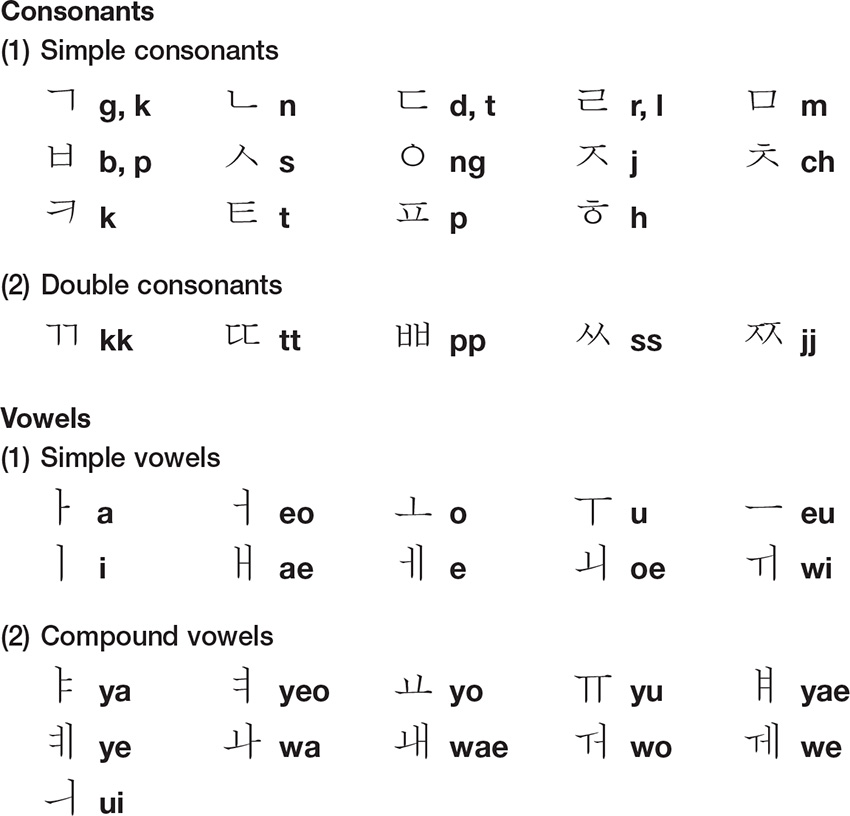 Vowelseo, eu, ae and oe are single vowels in romanized Korean as shown below. The Korean Alphabet and Roman Letters Vowelseo, eu, ae and oe are single vowels in romanized Korean as shown below. The Korean Alphabet and Roman Letters Vowelseo, eu, ae and oe are single vowels in romanized Korean as shown below. Vowelseo, eu, ae and oe are single vowels in romanized Korean as shown below. Therefore careful attention should be given to these vowels: take care that you are not splitting them into two. Also, careful attention should be given to u/do not read it as an English you. Some common vowels which might confuse you could be: | a | a h, f a ther | (shorter than these as) | | eo | b i rd, s e rve | | o | b a ll, p o re | (shorter than this a or o) | | u | b oo k, sch oo l | (shorter that these oos) | | eu | brok e n, gold e n | | i | b ee , sh ee p | (shorter than these ees) | | ae | a pple, b a d | | e | b e d, e gg | | oe | we ar, we lcome |
Consonants You wont have much trouble pronouncing romanized Korean consonants except for some tensed ones which require a relatively strong muscular effort in the vocal organs without the expulsion of air. Here are some examples: | kk | s k i, s k y | (k after s) | | tt | s t eak, s t ing | (t after s) | | pp | s p eak, s p y | (p after s) | | ss | s ea, s ir | (s before a vowel) | | jj | bri dg e, mi dg et | (similar to a tutting sound in an exhaling way) |
When reading in Hangeul, remember to read from top to bottom, then left to right. A consonant-vowel-consonant (CVC) syllable is written like this in Korean: | Next page
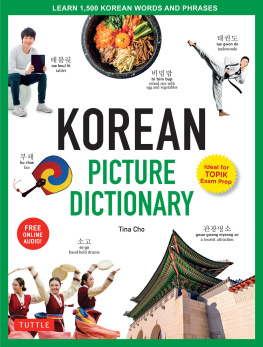

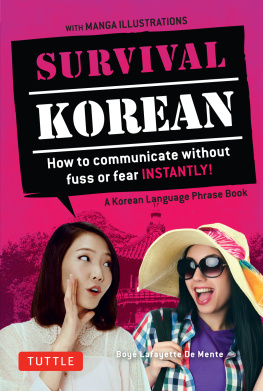
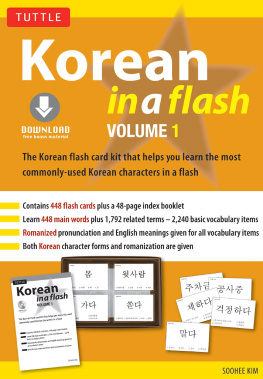
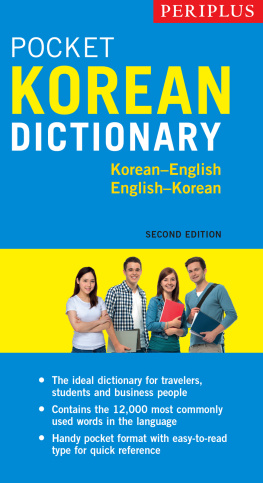
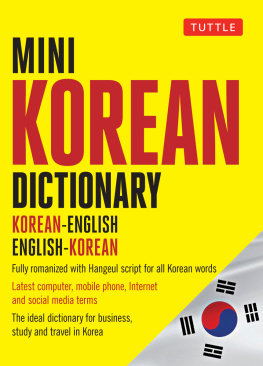
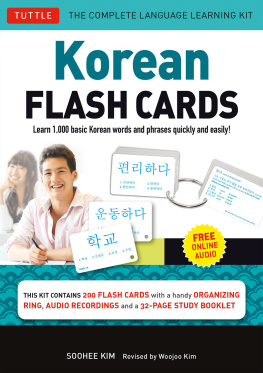
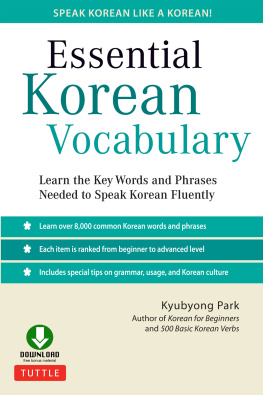
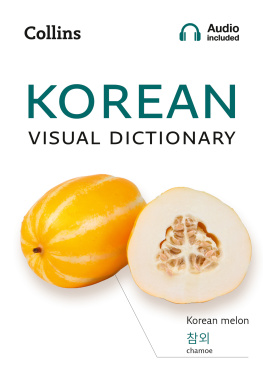
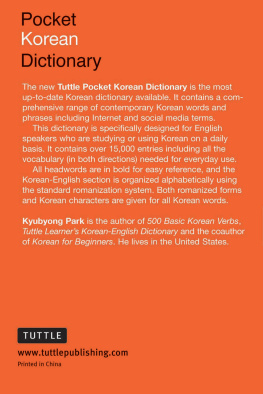
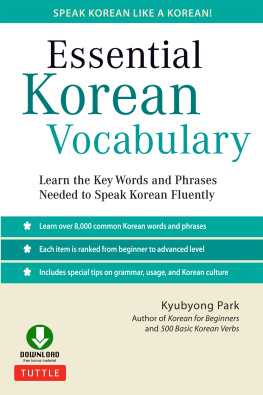
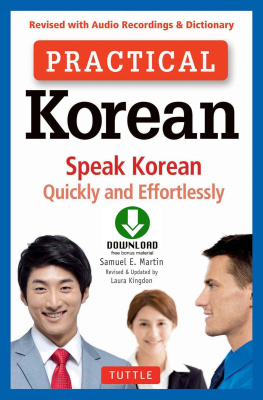
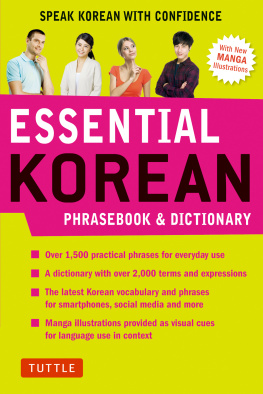
 A Basic Introduction to Korean Language This illustrated dictionary presents 1,500 frequently-used Korean words and phrases, including those that students need to know to pass the TOPIK, Test of Proficiency in Korean exam for non-native speakers. The dictionary is organized into 38 themes, each of which presents 30-40 words. Each section also has three to five sentences demonstrating the usage of the words. The words and sentences in the dictionary all appear in the following order: Hangeul characters, followed by the pronunciation in standard romanization form, followed by the English meaning. History of the Korean Language Researchers and linguists debate the origin of the Korean language. Some link it with the Altaic language family, which includes Mongolian, Turkic, and Tungusic language groups.
A Basic Introduction to Korean Language This illustrated dictionary presents 1,500 frequently-used Korean words and phrases, including those that students need to know to pass the TOPIK, Test of Proficiency in Korean exam for non-native speakers. The dictionary is organized into 38 themes, each of which presents 30-40 words. Each section also has three to five sentences demonstrating the usage of the words. The words and sentences in the dictionary all appear in the following order: Hangeul characters, followed by the pronunciation in standard romanization form, followed by the English meaning. History of the Korean Language Researchers and linguists debate the origin of the Korean language. Some link it with the Altaic language family, which includes Mongolian, Turkic, and Tungusic language groups. Vowelseo, eu, ae and oe are single vowels in romanized Korean as shown below. The Korean Alphabet and Roman Letters
Vowelseo, eu, ae and oe are single vowels in romanized Korean as shown below. The Korean Alphabet and Roman Letters